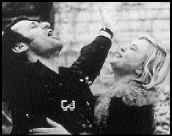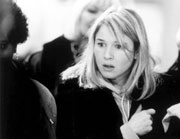Seventeen-year-old Susanna Kaysen must be crazy. She stares blankly at everything and everyone around her. She curls up and scrawls in her journal, and looks around in amazed horror a lot of the time. Which is precisely the complaint her doctors at the mental institution lodge against her—that she doesn’t communicate and is therefore hard to help.
Girl, Interrupted
directed by James Mangold
with Winona Ryder and Angelina Jolie
opens January 14 at Meridian, Metro, Oak Tree
Girl, Interrupted, which takes its name from Kaysen’s memoir, can be easily categorized by its premise and perhaps just as easily dismissed as the female ripoff of Milos Forman’s One Flew Over the Cuckoo’s Nest. But it can’t be ignored entirely. The story, as told through Ryder’s character, doesn’t candy-coat the problems from which some girls never recover; and it turns out to be a lot harder to watch young women, as opposed to men, suffer the indignities of institutionalization.
Susanna arrives at the Claymore Hospital in 1967 after washing down a lot of aspirin with a whole bottle of vodka. One tangible cause is an affair she’s had with a classmate’s father, but she’s diagnosed with borderline personality disorder. Susanna’s plight becomes a parallel for all the craziness going on in the world at the time. The Vietnam War and the civil rights movement are in full swing, as the film reminds us through scratchy TV clips, campaign signs, and the ubiquitous peace ‘n’ love anthems on the radio. The climate triggers a defense mechanism: Susanna sees herself as taking a respite from one nuthouse while inside the other. Still, Claymore isn’t a foolproof shelter.
In South Bell, the women’s ward, Susanna rooms with a pathological liar and watches television with incest victims, anorexics, and schizophrenics. She never completely fits in, though she does assimilate and form friendships. The world of Claymore is a kinder, gentler place than Jack Nicholson’s digs, but the visual formula remains the same: tiny Dixie cups filled with everyone’s pills (which no one actually swallows), the airy TV lounge and requisite card table, the nurses’ cage, and a trademark institutional colorlessness. Instead of Nurse Ratchett, there’s Whoopi Goldberg, whose unflappable character is both sympathetic and surprisingly calm, even when meting out punishment.
And, of course, every film that dares enter the mental ward had better have a Murphy, here gloriously played by the leonine Angelina Jolie, who as South Bell’s sociopath ringleader steals the screen from her doe-eyed costar. Jolie doesn’t walk through her lines so much as slither; she preys on individual weaknesses and revels in her loudmouth antics, which eventually draw Susanna to her. Like Murphy, she’s the dangerous rebel whose struggles to be normal only earn more electric shocks. She’s also the film’s onscreen life force, providing a needed jolt to Susanna’s quiet path to recovery.








